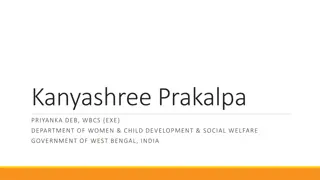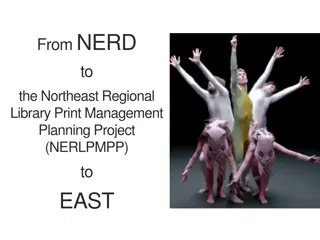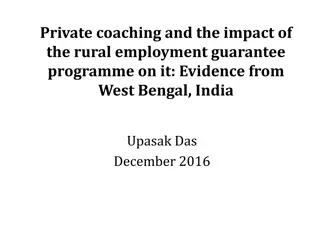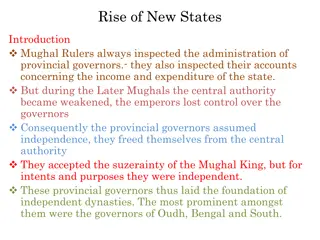Unleashing Bengal and Northeast's Regional Potential
Delve into the historical and present-day strengths and challenges of Bengal and the Northeast region, exploring opportunities for growth and integration in the evolving Asian landscape. Learn about the decline, emerging opportunities, and leveraging strengths to revitalize the region's economy.
Download Presentation

Please find below an Image/Link to download the presentation.
The content on the website is provided AS IS for your information and personal use only. It may not be sold, licensed, or shared on other websites without obtaining consent from the author.If you encounter any issues during the download, it is possible that the publisher has removed the file from their server.
You are allowed to download the files provided on this website for personal or commercial use, subject to the condition that they are used lawfully. All files are the property of their respective owners.
The content on the website is provided AS IS for your information and personal use only. It may not be sold, licensed, or shared on other websites without obtaining consent from the author.
E N D
Presentation Transcript
Harnessing Regional Potential: Bengal, the Northeast and Beyond SANJAY KATHURIA SENIOR VISITING FELLOW, CSEP CO-FOUNDER, TRADE SENTINEL VISITING PROFESSOR, ASHOKA AND GEORGETOWN DECEMBER 20, 2024 KOLKATA, RISING ASIA AND BCC&I SUMMIT
Presentation focus Historical context of Bengal Decline in modern day West Bengal and NER Emergence of new opportunities Looking to Asia Strengths of West Bengal and NER Reintegrating the region Leveraging Strengths
History of Bengal: leveraging its geography Strong civilizational links Rich history Sources of thought leaders British India capital till 1912 Rich trail in connectivity with East, Southeast and South Asia Coastal access Early industrialisation (and also de- industrialization?)
Regional decline West Bengal share of India GDP: 11.6% in 1950 to 5.9% in 2017 Manufacturing declined in both West Bengal and NER NER grew slower than the rest of India for many reasons, but have a lot to do with economic isolation, poor connectivity and hard international borders
but new opportunities emerging Geopolitical changes, especially the China plus one quest, as the world searches for new sources of supply Growing servicification of manufacturing (one third to one half) and even agriculture Increasing connectivity that reduces isolation and enables many new opportunities to leverage strengths India s Act East policy Growth of Asia and the subregion
Go West, young man? Not any more 19thcentury quote NY Tribune, Horace Greeley Now, it is the Asian century Pivot to the east: Obama India and SA fastest growing large country and region So the opportunities are in SA, the Bay of Bengal region, and in Asia, more broadly Modify and make politically correct: Go East, young people
Strengths of West Bengal and the Northeast Growing share of services. Tertiary sector 57% of WB economy FY23 (50% in FY12). Secondary sector down from 25 to 23%. Services sector rising in NER as share of GSDP, broadly Human resources of West Bengal: educational institutions Female labor force participation is much higher in NER than the national average: eg 35% and 23% is the share of women in secondary and tertiary sector, vs 21% and 18% for India Proficiency in English in NER states much higher than national: 4 of the top 5 states in English proficiency are in the NER Potential high value agriculture in NER, and traditional agriculture in WB Location and development of logistics in West Bengal to serve entire region
Connectivity thrust is helping the subregion to become a more coherent space Connectivity improving within NER, between NER and the rest of India, and between NER and subregion Rail Airports Coastal shipping Waterways Soft measures at the borders
What can be done to capitalize on strengths Going back to leveraging location and geography as a growth engine, with a close eye on the subregion Nursing, education and an open internal labor market to enable optimal leverage of regional skills Encourage hub and spoke model for medical services for NER and Bangladesh with Kolkata as the hub, and Guwahati as the internal hub for NER Foster delivery of digital services eg medicine, education, music, films, etc., potentially converted into offline services Deepen the Logistics value of West Bengal for NER, Nepal and Bhutan, and Bangladesh: for transit trade, regional value chains Focus urgently on soft connectivity and trade facilitation in the subregion to reduce the very high cost of trade and transit, e.g., through transit, multi-modal logistics, interoperability, operationalize BBIN, and so on Encourage FDI and domestic investment in NER to leverage its agriculture and services sector strengths. Japan can be a very important partner in this process.
Deepening linkages with the subregion: critical role of Bangladesh Market for India, Nepal and Bhutan Connector for NER and subregion Investor in NER and supplier of services Destination for FDI and creation of regional value chains in areas of strength eg garments --- Deepen interconnections in trade, connectivity, investment, energy, people to people Symbiotic relationship that needs to be nurtured
Concluding thoughts Emphasis on new growth poles for WB and NER Services strength and the human resources to deliver them e.g., education, medicine, films, research). Medical services a win-win with NER, for nursing and also for feeder and hub Logistics as a service to transport goods within subregion, and to help catalyze regional value chains High value agriculture and unique products What can be done to accelerate these developments and capitalize on strengths? Boost internet connectivity for ecommerce and service delivery Internal migration and seamless labor market needed not just for WB and NER but also to enable in and out migration Create a broader economic space with subregional countries, through deepening connectivity, especially softer connectivity; encourage FDI; promote people to people connect; accelerate subregional electricity market
Resources Kathuria, Sanjay; Zhu, Xiao ou. 2021. Regional Investment Pioneers in South Asia: The Payoff of Knowing Your Neighbors. South Asia Development Forum. World Bank. Herrera Dappe,Matias; Kunaka,Charles. Connecting to Thrive : Challenges and Opportunities of Transport Integration in Eastern South Asia. World Bank Group. Kathuria, Sanjay and Mathur, Priya. Playing to Strengths. A policy framework for Northeast India. World Bank. Trade Sentinel: www.tradesentinel.org THANK YOU
Government investing heavily in improving connectivity in NER (I) Investing in upgrading and expanding road network within NER and between NER and neighbors Extensions of the national highway network 3 emerging corridors with neighbors - Trilateral Highway (India-Myanmar-Thailand), Kaladan multi-modal corridor (NER to Sittwe port in Myanmar), BCIM economic corridor (Bangladesh-China-India-Myanmar) Investing in extending railway network and broad-gauging, within NER and with neighbors India- Bangladesh: Plans underway to connect to Bangladesh (Sabroom-Chittagong, Agartala-Akhaura) India Nepal: Two operational railway lines; plans for four more rail links India Bhutan: Currently not connected, but five potential rail links identified India Myanmar: Rail lines reaching Imphal (Manipur); survey being conducted to link Imphal to Moreh (Manipur) on the India-Myanmar border 1.
Government investing heavily in improving connectivity in NER (II) Making more airports operational Plans announced to make more airports operational in NER and enhance direct air connectivity between Guwahati (Assam), the regional hub, and key destinations in South Asia and Southeast Asia; bids for routes Guwahati-Dhaka and Guwahati-Bangkok approved in January 2019 Activating waterways Plans underway to improve navigation of the Brahmaputra River (National Waterway 2) Improving trade facilitation Plurilateral measures like signing of the (Bhutan-)Bangladesh-India-Nepal Motor Vehicles Agreement ((B)BIN MVA), which when implemented will allow vehicles to cross borders in this region without the need for transloading cargo or passengers Bilateral measures include recognition in April 2017 by the Food Safety and Standards Authority of India of testing and certification by the Bangladesh Standards and Testing Institution for imports of 21 Bangladeshi food products into India 1.
Appropriate policy interventions can help maximize impact of connectivity investments (I) Developing logistics hubs and corridors to consolidate traffic along a few long- distance corridors and at a few nodes 3 potential hubs at Guwahati, Silchar and Agartala Ensuring interoperability of transport systems by standardizing infrastructure standards, especially along the major corridors, to allow seamless cross-border services Improving trade facilitation Eg., allowing cargo vehicles to cross borders without the need for transloading; creating adequate space for transloading until such a system prevails; aligning and widening access roads and creating adequate parking space on both sides of the border crossing point; allowing processing of split consignments; introducing a system of pre-arrival processing of documents; synchronizing border opening hours on the two sides; training border officials on trade policy 1.
Appropriate policy interventions can help maximize impact of connectivity investments (II) Modernizing private sector logistics practices Encourage private sector to invest in warehouses and handling facilities (e.g. pallets and cranes for transloading) Opening up the logistics services market in NEI to Bangladeshi operators, and vice-versa Introducing a through transit system within South Asia and between South Asia and Southeast Asia (B)BIN MVA will help Promoting multi-modal logistics. Multi-modal logistics can help lower costs by exploiting the comparative advantages of each mode. Multi-modalism has to be supported by appropriate policies, especially on transfer of risks and liabilities across modes Expanding air connectivity - Given NER s difficult terrain and distance from markets in the rest of India, air transport has significant potential to sustain commerce and tourism and realize the potential of horticulture in the region 1.
Indias Act East policy, connectivity in NER: an opportunity to unlock the region s potential Act East Policy NER is the critical connector in BBIN and between India and ASEAN Connectivity thrust Investment in road network within NER and between NER and rest of India Emerging corridors with neighbors - Trilateral Highway, Kaladan multi-modal corridor, BCIM economic corridor Investment in extending railway network and broad-gauging, within NER, with plans underway to connect to Bangladesh (Sabroom-Chittagong, Agartala-Akhaura) Making more airports operational Activating waterways Deepening relationships with neighbors Growing economic ties with Bangladesh (trade, energy, waterways, ) BBIN Motor Vehicles Agreement (now BIN) transit through BD will be a game-changer Use of Mongla and Chittagong for transport of goods to and from India























